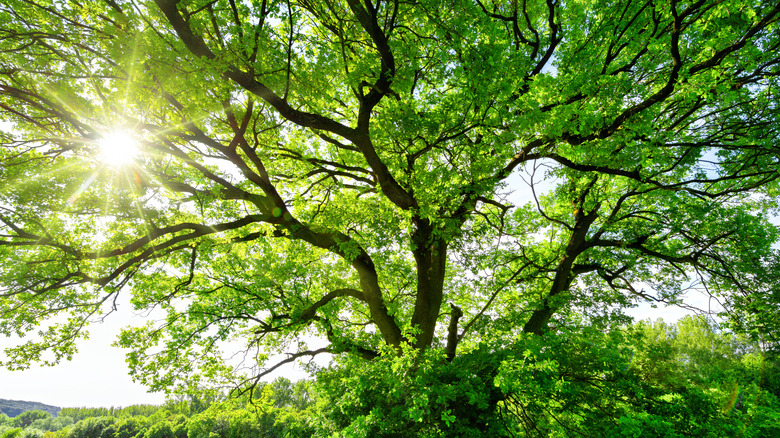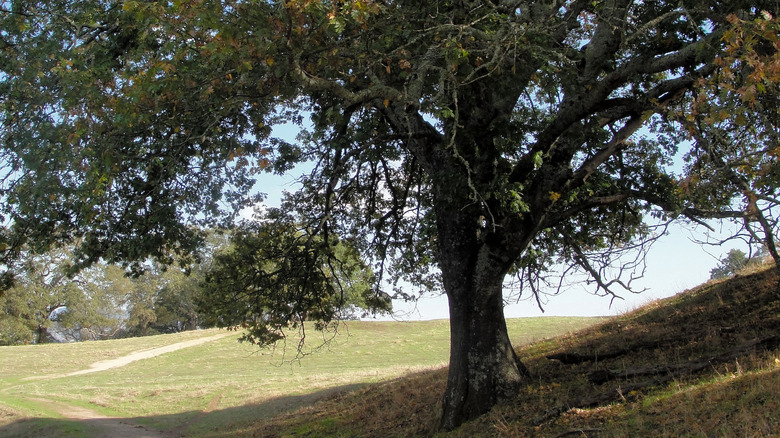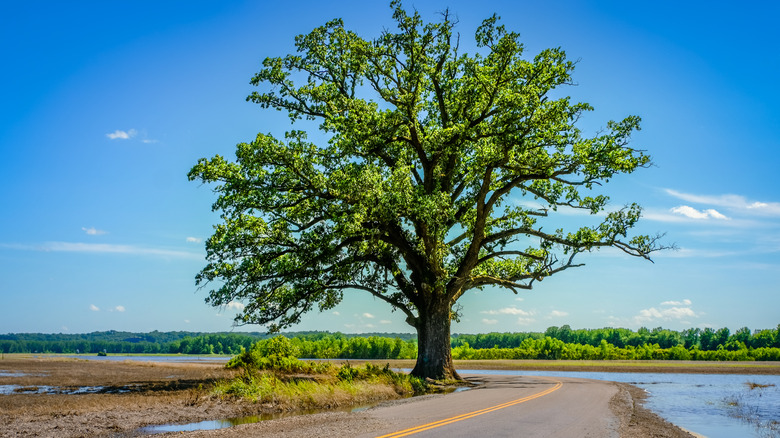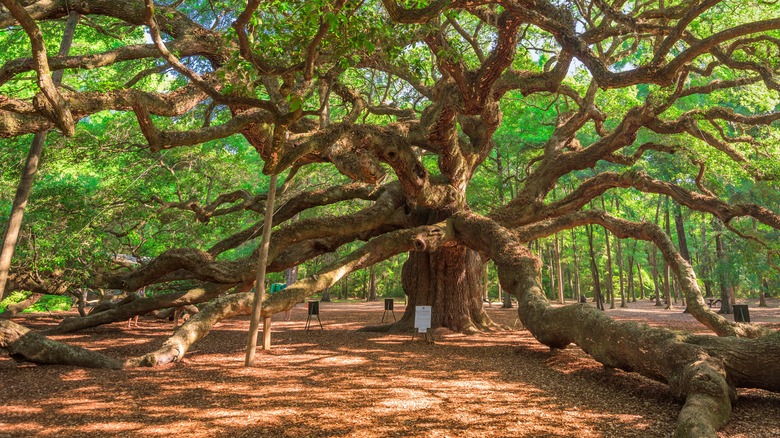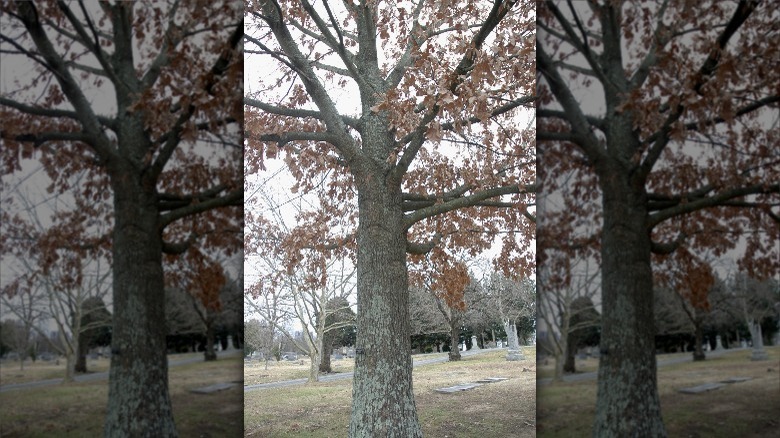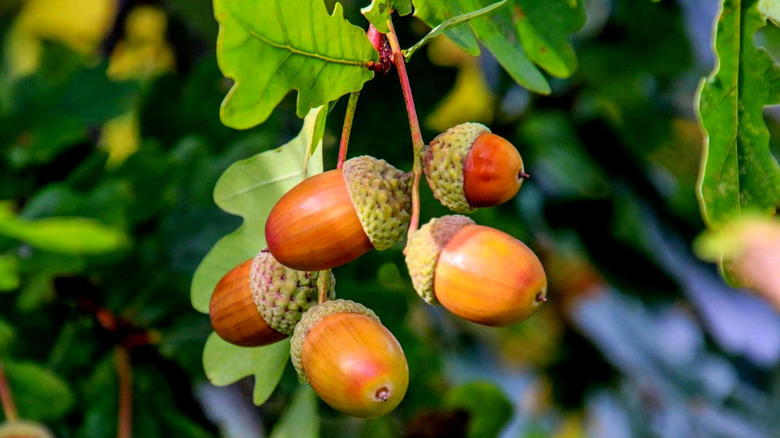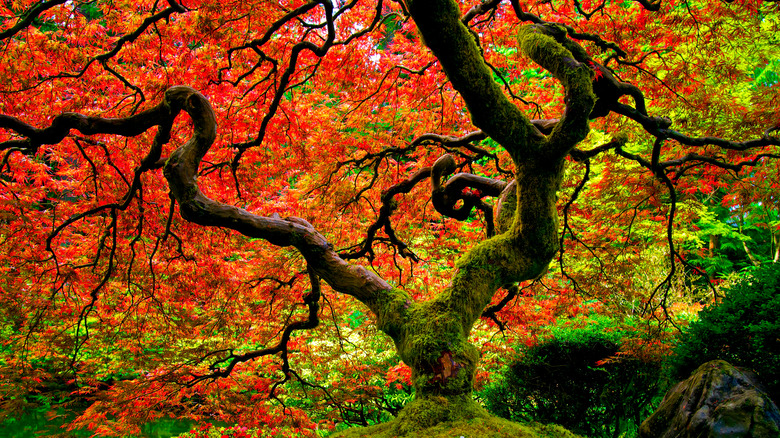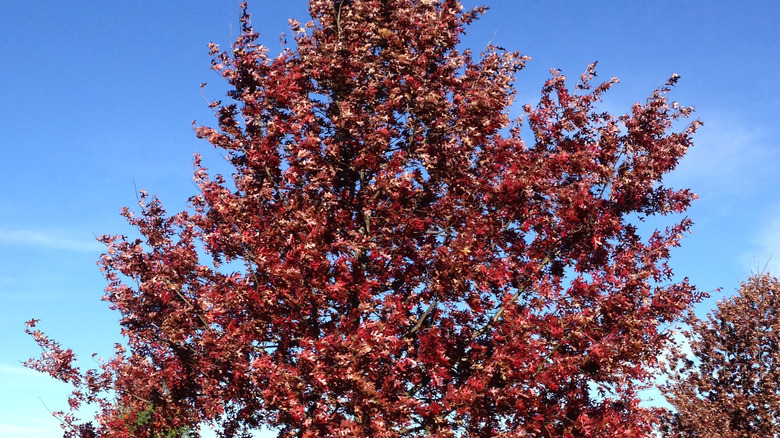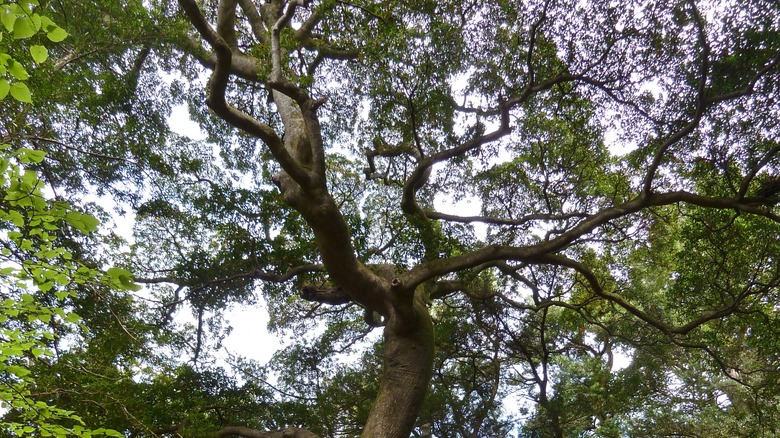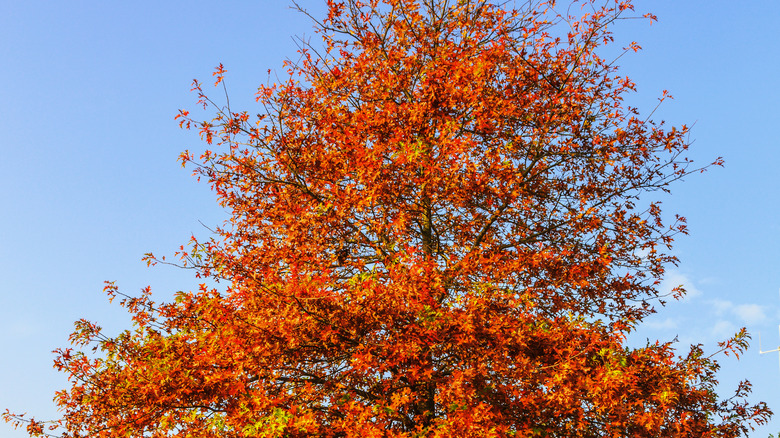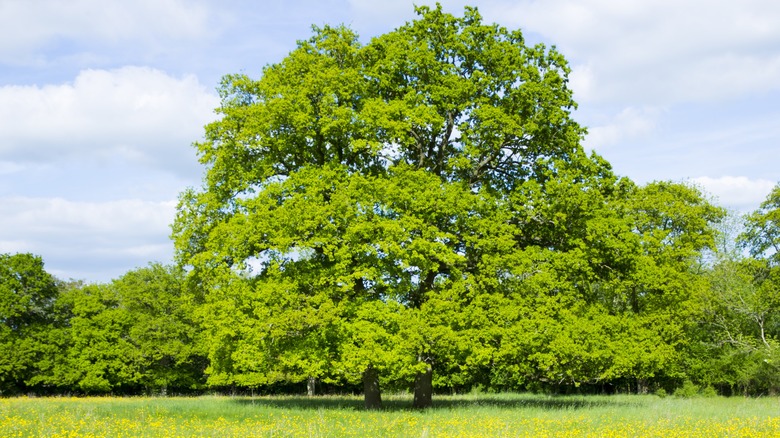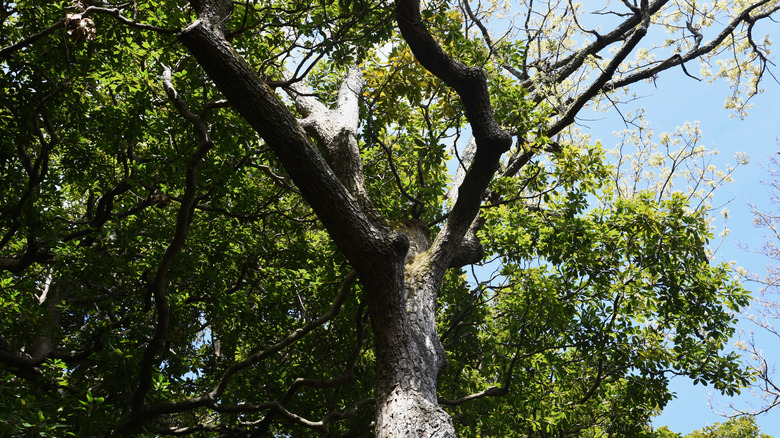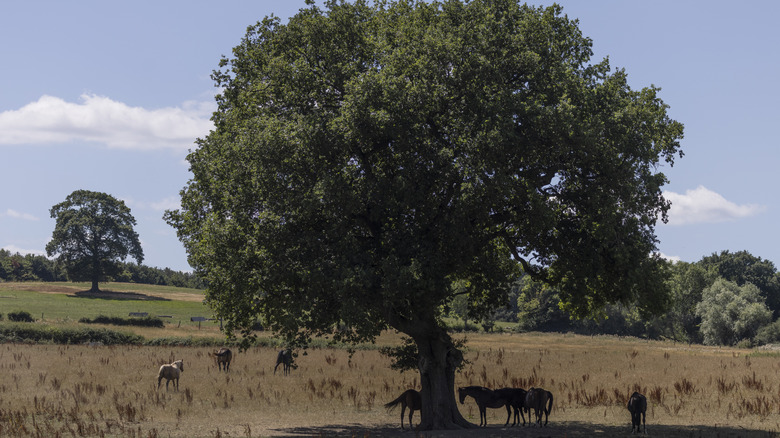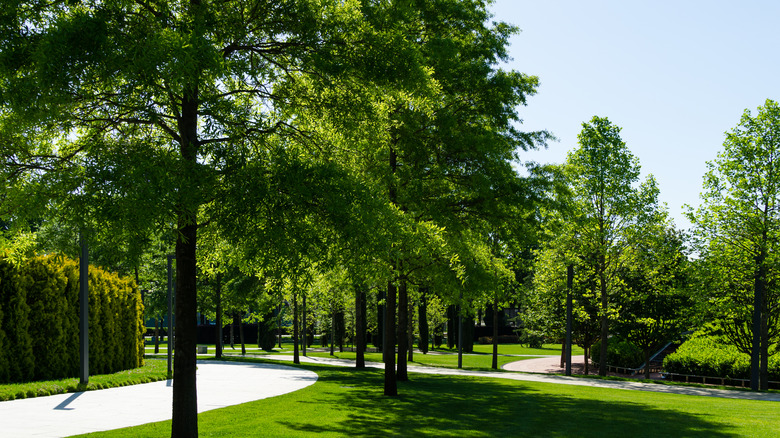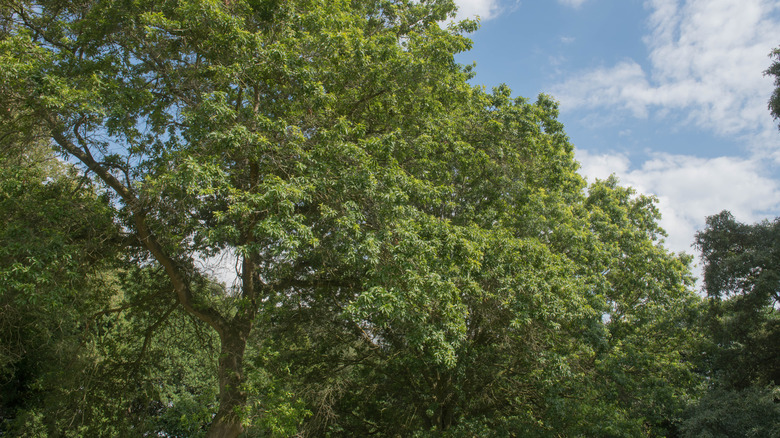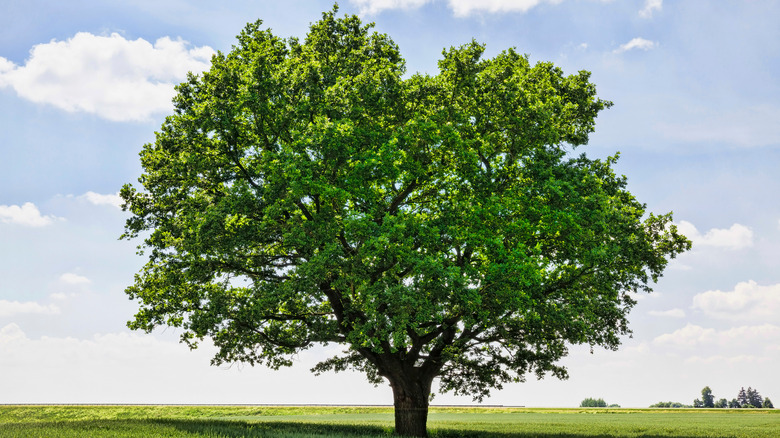15 Types Of Oak Trees You Can Plant In Your Yard
Planting a tree is one of the best things you can do for both your yard and the overall climate. Trees provide shade as they grow, attract wildlife for you to observe, and also last for generations. Trees can also absorb carbon dioxide from the air and emit oxygen. According to the Napa County Resource Conservation District, trees combat climate change by lowering the overall ground temperature through shade. This gives animals and other smaller plants below a chance to thrive, despite rising temperatures.
If you are interested in planting a tree in your yard, the oak tree is one of the best types to choose from. Oak is a genus made up of about 450 different species. They are easily propagated and tend to occur naturally in most parts of North America and Europe, as well as parts of northeast Asia (via Britannica). These 15 trees represent just a slice of the great biodiversity of the oak tree genus.
1. Black oak (Quercus velutina)
According to the Central Park Conservancy, the black oak tree gets its name from the dark color that its bark takes on as the tree ages. For this reason, the tree is very easy to identify. While the outside of the tree is dark, the inside of the bark is actually a yellowish hue, which early European colonists used to make dye. It's a very attractive tree for personal use for these reasons.
The tree grows in many places across the United States and Canada but is most concentrated in the southeastern portion of the country. It is a great food source for wildlife, as its acorns are a known favorite of squirrels, deer, mice, and birds. In some cases, animals also eat the leaves of this species (via U.S. Forest Service). If you were hoping to create a lawn full of wildlife, then planting a black oak tree would be a great choice.
2. Bur oak (Quercus macrocarpa)
According to the National Arboretum Canberra, the bur oak tree is a great choice for your yard as its lifespan is typically about 300 years. Not only will your grandchildren be able to enjoy the tree, but it's also likely that theirs will, too. The tree is native to North America and is mainly found in portions of the east and the midwest United States, as well as the southern bit of central Canada. As far as oak trees go, the bur is one species that does the best in cold weather. If you live somewhere with long and cold winters, you can usually be sure that your bur oak will come out of the other side relatively unscathed.
The tree grows tall and wide, creating a vast network of branches that make a great shade canopy. If you are the type who likes a place to relax under a tree, then planting a bur oak could be a great option for your yard. In fact, the canopy is so vast that just one tree can shade the entire patio at one restaurant (via The Diggers Club).
3. Southern live oak (Quercus virginiana)
The southern live oak tree is a staple in most of the sprawling estates of the southern United States. You can find them in Virginia, and they thrive all the way down the coast to Florida, as well as clear across the south to the far west reaches of Texas. According to The National Wildlife Federation, it's easy to recognize this species because of its unique branches. The live oak tree grows outwards just as much as it grows up, creating a tumbling scramble of interconnected branches that scrape the ground before rising again. If you have a live oak in your yard, this branch network creates great opportunities for any neighborhood kids to get really good at climbing trees.
Southern live oak trees function as evergreen trees, unlike many other types of oak. This means that their bright leaves stay green all year round. When they do decide to replace their leaves with fresh ones, it's just over a few weeks in the spring. The tree will drop nearly all its leaves at once instead of turning bright colors in the fall and losing them gradually.
4. Cherrybark oak (Quercus pagoda)
According to the Missouri Department of Conservation, the cherrybark oak tree is usually one of the smaller types of oak. It's typically medium in height, although sometimes it can grow quite large — up to 100 feet high. You can recognize it because there are no branches on the tree trunk. Instead, you'll need to move your eye farther up, nearly to the top of the tree instead. There, you will see that the top of the tree is a very open space, too.
It's a special tree because it is only found natively in certain forests in the southeastern part of Missouri. The soil in that area is very well drained, so the tree can do well in pretty much any dirt that might be a little bit too dry. Although rarely sold, if you live in Missouri or a climate with poor soil, the cherrybark oak tree is a hardy tree that requires little care — making it the perfect choice for your yard.
5. Chestnut oak (Quercus montana)
The chestnut oak tree is a great choice to plant in your yard if you have a bit of a rocky lawn or live on uneven land. According to the University of Kentucky, the tree has strong roots that can hold on tightly, even when there isn't much to grip onto. It is native to Kentucky but can be found in rockier areas throughout the eastern United States. The tree does okay in winter, so if you live in a colder climate, there is no need to worry.
It grows pretty quickly and can soon rocket up to heights of 60 to 70 feet without too much fuss. The tallest chestnut oak tree currently on record is a staggering 144 feet tall. If you want to see it in person before you plant one at home, that tree is in Tennessee at Great Smoky Mountains National Park. The tree has a popular bark that looks almost silver and white at the same time, instead of brown like most other trees.
6. Northern red oak (Quercus rubra)
The northern red oak is a tree that puts on a spectacular performance each fall. According to the Arbor Day Foundation, the tree's leaves turn bright red each year when the weather gets a little chillier. It has a large, thick spread of leaves that, when you look really closely, seem to bristle towards the tips. If you were to pick one up, you might notice that they feel a bit waxy to the touch.
If you plant one in your yard, you can also look forward to a large tree that just keeps on growing. In fact, the northern red oak will grow and grow, up to two feet a year for as much as a decade. To achieve this, your red oak will need plenty of direct sunlight each day — preferably at least six hours. So, when you first plant it, take care not to place the sapling in the shadow of any large existing trees with dense canopies, or you might dwarf its growth.
7. Scarlet oak (Quercus coccinea)
The scarlet oak tree is one of North America's oldest observed oak trees. According to the Arbor Day Foundation, the tree was first noted by scientists way back in 1691. It can be found naturally across large swathes of the country, too — growing down the entirety of the east coast from Maine all the way down to Florida and even west into Missouri. The reason the scarlet oak grows so well in so many different climates is that it has a root system that isn't picky and can thrive in most conditions.
If you live somewhere with long, snowy winters, the scarlet oak is an especially great choice for your yard because of its bright namesake: its scarlet leaves. In the autumn, the tree turns a vibrant shade of red; however, unlike other trees, this oak hangs on to its leaves well past the first snow. So, you'll get the treat of looking out across the lawn to see a blood-red display over pure white snow each morning.
8. Japanese evergreen oak (Quercus acuta)
The Japanese evergreen oak is one of the smaller oak trees. According to the University of Florida, it is about 20 to 30 feet high when fully grown. However, its canopy is a further 15 to 20 feet across so that the tree can provide dense shade to areas around it. As the name suggests, this tree is not native to North America but comes from Japan. It also grows naturally in parts of China and North Korea.
Although it has very low potential as a full-on invasive species, purchasing a sapling at a nursery is more difficult. Instead, you might need to propagate this tree directly from an existing one. You will be able to find the Japanese evergreen oak growing in parts of California, Florida, and Texas. The tree has a strong trunk and does well against very strong winds, but it doesn't do well in coastal areas or places with waterlogged soil (via Plants for a Future).
9. Pin oak (Quercus palustris)
According to Brittanica, the pin oak tree gets its name from a unique aspect of its appearance. If you look closely, you might notice that its smaller branches are very slender and stick out from its trunk and anchor branches quite sharply — kind of like pins on a pincushion. The tree usually grows to about 80 feet tall, so if you have room in your yard, it will end up looking very majestic. In some cases, the tree's upper branches can even reach heights of 115 feet.
They do best in the eastern and central regions of the United States, especially in places where the soil is nice and moist all year round. In the fall, you are in for a real show, as the pin oak turns bright red once the air starts getting colder. However, a small subspecies, the northern pin oak, also turns a brilliant yellow instead.
10. English oak (Quercus robur)
According to the Woodland Trust, the English oak is sometimes called the common oak. It is one of the most common trees in the United Kingdom and plays a great role in the area's biodiversity. It provides a place for native birds to build their nests, as well as food for smaller mammals through its acorns. The English oak not only has great biological significance, but cultural significance, too. Druids used to perform ceremonies under the shades of the oak tree, and old English kings wore crowns made of its leaves.
Although primarily found in the U.K., the English oak is also widely cultivated in North America (via Britannica). It does well in sweltering summers, but can also stand the harsh cold of a long winter, so you will find that no matter where you live in the United States, the English oak is likely to thrive in your yard, too.
11. Sawtooth oak (Quercus acutissima)
According to the NC State Extension, the sawtooth oak is an oak that originally comes from Asia, with a high concentration in China and Korea, as well as central and southern Japan. In the United States, you can mostly find it in the southeast portion of the country. Some states classify the tree as invasive because of its origins overseas, while others do not. Before planting a sawtooth oak in your yard, check your local regulations to ensure you are allowed.
The tree grows to a solid 75 feet high and tends to splay its leaves in a sort of reverse pyramid shape, so they are wider at the top than at the bottom. The sawtooth oak can begin producing acorns at around 10 years old. This is a lot younger than most other trees, which can't produce them until well into adulthood. However, these acorns tend to be a bit bitter and not eaten by most wildlife.
12. Water oak (Quercus nigra)
The water oak grows naturally in the central and eastern parts of the US.., but the most common place to find it is in the coastal plains of North Carolina. According to NC State Extension, the tree typically grows best along streams and in flood plains — that is, places where the soil is nice and wet. However, in some cases, you might also find the water oak in a sloped area with drier soil, like on the edges of a riverbank with lower water levels.
In most parts of the country, the tree turns brilliant colors in the fall and loses its leaves at the end of the year. However, in the warmer parts of the south, the water oak is actually an evergreen tree because it never gets quite cold enough to trigger this process. The water oaks in the south have one other advantage over their northern counterparts: temperature. The tree doesn't do as well in the cold, as the limbs can easily become brittle and snap. If you live in a colder climate, you will need to be mindful of trimming back the tree to protect your home and car from falling branches.
13. Willow oak (Quercus phellos)
The willow oak likes to grow near water, so if you have a pond, river, or lake near your home, it could be a great choice for your yard. According to the U.S. Forest Service, the tree grows best in the southeast United States. Starting in the eastern portion of Texas, its range sweeps across to the southern part of Kentucky and ends in eastern Virginia. The tree is famous for growing quickly and living a long time, so if you are trying to make your property appealing to future generations, the willow oak is a good investment.
Another great thing about the willow oak is that it is easy to move, especially when it is younger. If you aren't sure how long you will be in your current home and would still like to get a jump start on a great shade tree, buy a willow oak. When the time comes to move, you don't have to worry — your tree can come along with you, too.
14. Laurel oak (Quercus laurifolia)
The laurel oak does well in places that rain a lot, as it thrives in wet soil. According to the University of Florida, its native range forms a giant u-shape across the United States. Starting in the Pacific Northwest, scooping down along the coast across to Texas and through to Florida, before turning up to encompass parts of Pennsylvania. Like many other oaks, this tree typically reaches 70 feet at full maturity and has a canopy that spreads about 45 feet across.
The laurel oak typically lives about 70 years; however, it is particularly prone to rot, which can shorten its life. If you plant one in your yard, you will need to be proactive about trimming its lower branches and ensuring no large branches are too high up. If these larger branches fall, they can cause significant damage, so as a general rule, get rid of any that look more than half of the trunk's diameter.
15. White oak (Quercus muehlenbergii)
The white oak tree is a tree that is popularly used for its strong timber in the United States. Even so, it's still worth having in your yard because it provides great shade. According to Sciencing, the tree is mainly concentrated on the eastern side of North America but has a very long range — from southern Canada to Florida. However, you can sometimes find the tree as far west as Minnesota.
The white oak tree is famous in the U.S. as it is the state tree of Maryland, Illinois, and Connecticut. If you live in any of these states, you might find that having a white oak in your yard not only provides you with a beautiful, lush green canopy but can also make you feel a little patriotic. You will just need to keep an eye on it to protect it from any larvae pests like the gypsy moth, the oakleaf caterpillar, and the orange-striped oakworm, as white oaks are particularly vulnerable to their attacks.
